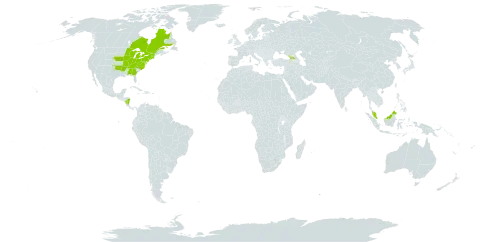Culms densely tufted, lateral, ascending or lax to decumbent, distinctly winged, 10–62 cm × 2–2.4 mm; basal sheath light brown to brown, the proximal frequently wine-red or purple, small, triangular. Leaves: sheaths 2–15 mm; blades ascending, midrib well developed, 2 lateral veins conspicuous, slightly more so than other veins, flat, thin, 10–35 cm × 10–38 mm, widest leaf 13–38(–62) mm wide, blades of overwintering leaves smooth. Inflorescences: peduncles of proximal spikes to 5.8 cm; of terminal spike absent. Bracts 1.4–2.6 cm × 3.9–2.2(–3.2) mm; bract blades of distal lateral spikes lanceolate or narrowly lanceolate, wider than spikes, concealing them, widest bract blade of distalmost lateral spike (2.9–)3.2–8.3 mm wide. Spikes 4(–5) per culm; lateral spikes 6–36 × 3–4.2 mm; terminal spike erect, linear, 4–18 × 1.2–1.6 mm, often hidden by distal 2 pistillate spikes and distal bract blade, frequently exceeded by distal 2 pistillate bracts. Pistillate scales oblong, 2.8–3.2 × 1.4–2 mm, apex obtuse or truncate, awnless (sometimes mucronate). Staminate scales oblong ovate, 2.8–3.2 × 1.4–2 mm, margins hyaline, apex obtuse. Anthers 2–2.2 mm. Perigynia 3–20 per spike, strongly to loosely overlapping, erect or ascending, obovate, 3–4.2 × 1.8–2.1 mm; beak abruptly bent, 0.3–0.6 mm. Achenes ovoid, 2.5–3.8 × 1.6–1.8 mm. 2n = 44.
More
Tufted, 2–6 dm; fertile stems triangular and slightly winged, roughened on the angles; basal sheaths mostly brown, but the immediately suprabasal ones often purple; lvs of the sterile shoots 10–50 mm wide, of the fertile ones 4–16 mm; angles of the bract-sheaths minutely ciliate-serrulate; terminal spike staminate, 0.5–2 cm, sessile or nearly so, often hidden by the uppermost pistillate spike and its bract; pistillate spikes 3 or 4, 1–3 cm, the uppermost one or 2 near the staminate peduncle, the others remote, on short to elongate peduncles, none basal; pistillate scales broadly obtuse or subtruncate, only minutely apiculate; perigynia 3–20, ± overlapping, 3–4.2 mm, greenish-stramineous, finely many-nerved as well as 2-ribbed, obtusely trigonous, obovoid, with a short, abruptly bent beak; achene convexly trigonous; 2n=44. Rich woods, especially in calcareous regions; Vt. and s. Que. to Minn., s. to S.C. and Ark. (C. laxiflora var. latifolia)

